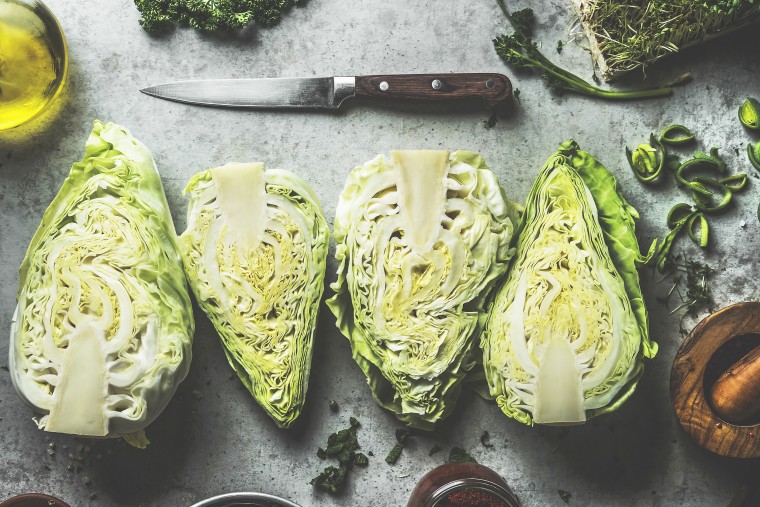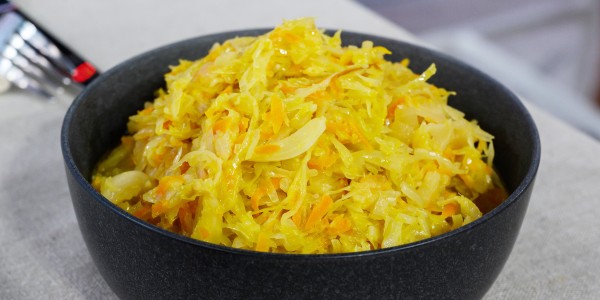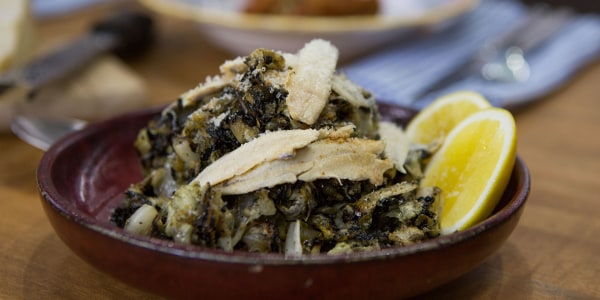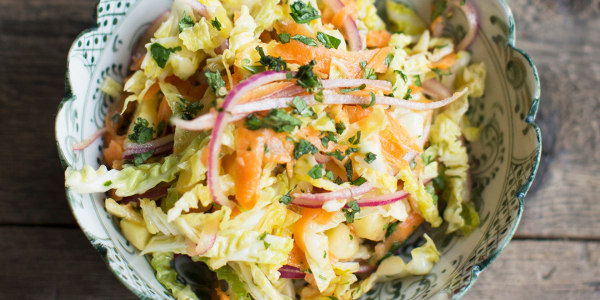The humble cabbage is a cruciferous vegetable that packs a big nutritional punch into very few calories.
Although it’s been cultivated for thousands of years, cabbage doesn’t always get the love it deserves. Maybe, like me, you grew up eating boiled cabbage on Irish holidays and wrote off the veggie entirely.
But cabbage is making a comeback, especially with the soaring popularity of its varietals, like Brussels sprouts and Napa cabbage. And with good reason, since cabbage is a good source of fiber, vitamin C and vitamin K. With its crispiness, it also adds a nice texture to plenty of dishes, from salads to tacos. Plus, it's the perfect veggie for fermenting and turning into sauerkraut or kimchi.
Learn the health benefits of cabbage, as well as some fun facts and recipes that should convince you to add it to your cart.
Cabbage nutrition facts
One cup of chopped cabbage has:
● 22 calories
● 1 gram protein
● 0 grams fat
● 5 grams carbohydrates
● 2 grams fiber (7% daily value (DV))
● 33 milligrams vitamin C (37% DV)
● 68 ug vitamin K (57% DV)
The health benefits of cabbage
Cabbage is an ancient vegetable that grows in more than 90 countries. It contains many nutrients, such as fiber, vitamin C and vitamin K, as well as antioxidant compounds like myricetin, quercetin and polyphenols. Red cabbage has a plant compound known as anthocyanin, which has been linked to heart health benefits. As a matter of fact, one animal study found that red cabbage microgreens lowered LDL (bad) cholesterol levels in mice after 8 weeks.
Cabbage is part of the cruciferous vegetable family, along with arugula, bok choy, Brussels sprouts, cauliflower, collard greens, kale, radishes, rutabaga, turnips and watercress. These nutrient-rich veggies have been linked to a reduced risk of mortality, depression and cancer.
According to the National Cancer Institute, cruciferous vegetables contain anticancer compounds that are activated during the chewing and digestion process. In addition, various studies have shown an association between eating cabbage regularly and lower incidences of lung and breast cancer.
The bioactive compounds in cabbage have also been shown to be effective in nutritional therapy for type 2 diabetes. A review states that eating cabbage is associated with a lower risk of developing the disease, and it may reduce damage to organs affected by diabetes complications, such as the liver and kidney.
Are there drawbacks to eating cabbage?
The only downside to eating cabbage is that it may cause gas and bloating in some people. Cabbage contains a sugar called raffinose, which is left undigested until the bacteria in the gut ferment it. This fermentation can cause gas and bloating. That said, cooking cabbage makes it easier to digest and may lead to less gas. Rather than boiling cabbage, which takes away the flavor, nutrients and crispiness, try blanching or roasting it to bring out the taste.
More Nutritional Information on Everyday Foods
Fun facts about cabbage
These interesting tidbits are a few more reasons to add cabbage to your diet.
Fermented cabbage is good for the gut
Cabbage’s crispy texture makes it perfect for fermenting in a brine. The process of soaking cabbage in a salt brine encourages the growth of good bacteria, otherwise known as probiotics. It’s the starting point for both sauerkraut and kimchi, two tasty condiments that are chock full of probiotics. These critters flourish in the gut and contribute to a healthy microbiome, which is linked to many positive health aspects, like immunity and good mood.
It may help with mastitis pain
Mastitis is a painful inflammation of the breast tissue that may occur while breastfeeding. It’s also accompanied by fever, swelling and redness of the breast. Interestingly, there is some evidence to suggest that putting cabbage leaves on inflamed breasts may reduce swelling and alleviate pain. The science is spotty, but many moms swear by this therapy. The mechanism behind the treatment is not known, but some believe it’s due to the cold nature of the cabbage leaves and the inflammation-fighting compounds in the veggie.
Cabbage juice was once thought to cure stomach ulcers
One study from the late 1940’s claimed that drinking cabbage juice rapidly cured stomach ulcers. For years, many people believed in this science and drank cabbage juice to cure their stomach ailments. Unfortunately, the science has not been validated with newer research, and many healthcare professionals recommend ulcer-fighting medications, rather than guzzling cabbage juice.
Healthy cabbage recipes
There are many creative ways to enjoy cabbage, from slaw to kimchi to wedges to salad. Here are some of our favorite cabbage recipes.








